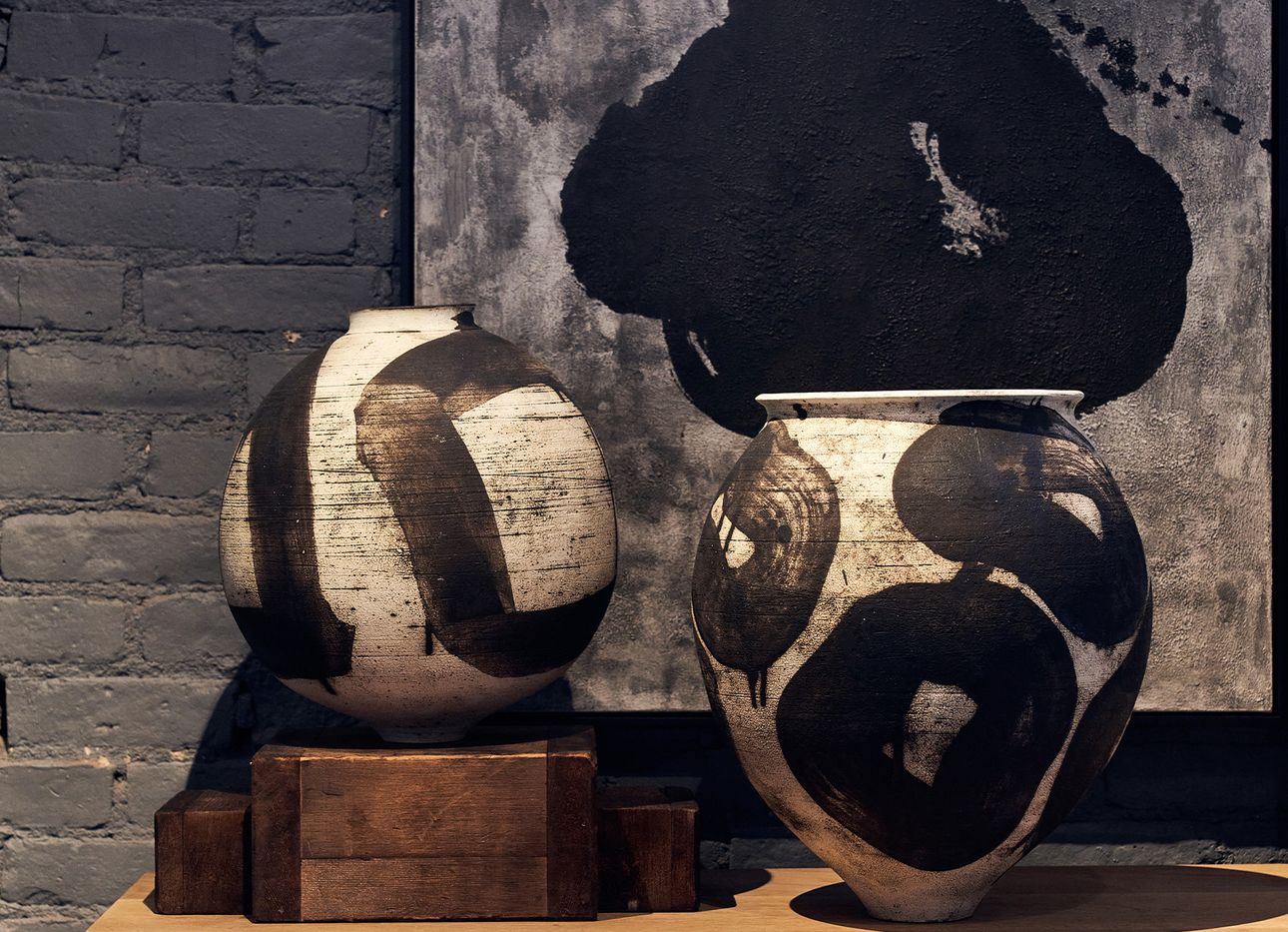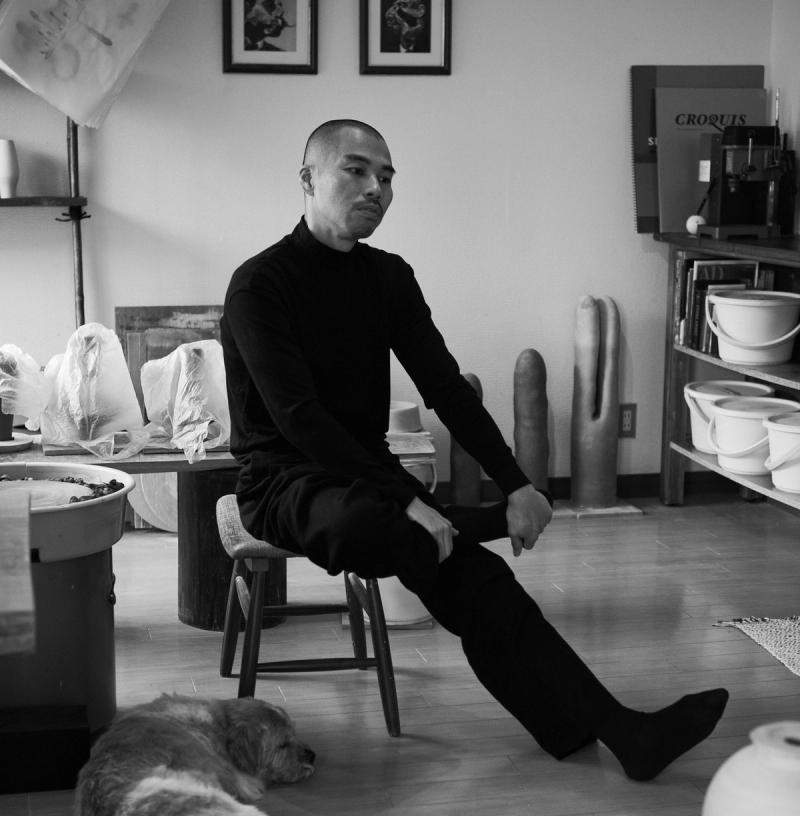
Sound Is at the Core of Musician-Turned-Ceramicist Kansai Noguchi’s Vases and Vessels
From his Tokyo studio, Japanese artist Kansai Noguchi crafts striking, one-of-a-kind ceramic vases, vessels, and painted canvases that make a bold first impression that invite the eye to linger on their mesmerizing visual contrasts. His preference for working in a limited palette is obvious, and is inspired by ceramics of Japan’s Jōmon period (10,500–300 B.C.), considered among the oldest pottery in the world. Noguchi’s approach isn’t just about visual aesthetics; equally present in his pieces is their ability to possess “sounds of music.”
Noguchi traces this sonic connection to his earlier life as a musician, which began on Japan’s Shikanoshima Island, where he was born in 1982. In high school, he started playing music, and set out for Tokyo to build his career as a singer and songwriter. When a friend questioned the then 30-year-old about writing and performing American jazz and R&B music in Japan, Noguchi felt compelled to travel to the United States. On stage in a New York City jazz bar, he sang while thinking to himself, Oh, please, make this song end soon, realizing that making music in the traditional sense was not to be his path.
Motivated instead to practice something that he identified with his home country, Noguchi shifted to ceramics. Back in Japan, he trained with sculptor Takuya Yoshida and ceramicist Ikuko Hiyoshi, and later bought a throw wheel and kiln. In 2016, he founded his own studio to create art that connects archaic culture with the present day. Working with clay, glazes, and brushes, Noguchi crafts vases in a variety of shapes, sizes, and textures (available in the U.S. at the New York home goods store and gallery R.W. Guild) that meld his musical background and skill as a craftsman. Manifesting a distinct sense of “Japanese-ness” that was missing from his life as a musician, they channel his native country’s rich pottery traditions while simultaneously evoking its enduring associations with precision, beauty, and modernity.
We recently spoke with Noguchi, through a translator, to understand his creative arc up to now and how he coaxes sound from clay.

You’ve previously said that going to the U.S. changed your life. What happened there that made you reconsider your medium of creative expression?
I chose to go to New York, which was my dream. By doing so, I thought that I would know if I should continue music or stop—by going to the country where the music I was attempting to make originated, and was being produced. When I actually got there, I was surprised with the scene and how different it was from Japan. I realized that I couldn't do it anymore.
After aiming to be a musician for more than ten years, the accumulated time, money, and effort were getting in the way of my judgment. So I thought that by letting go of all of the instruments and belongings and starting from scratch, I would be able to think from scratch about what I should do to be successful.
On that trip, I had no money and only time, so I visited as many free museums as I could find. I had no knowledge of art at all. I encountered art from around the world, and also Japanese kogei [crafts], as well as works by [the Japanese-American artist] Isamu Noguchi. The air that Isamu created was invisible, but I think I was able to feel it, as I had been working with expression through my music without physical objects. I remember Isamu’s work feeling very quiet to me. In America, I was able to see Japan from the outside, and my interest in Japanese craftsmanship began.
How do your ceramics represent an evolution from your work as a musician?
When I was making music, Western music was my role model. So it felt like there was another self, an unreal self, or a manufactured self. Now, instead, I’m following the example of my predecessors in Japan and making things that originate in my own mind. I don’t have a fake self. I think that my ceramics represent the best way to express Japanese-ness for me as a Japanese person, and to create without faking anything.
You strive for your ceramics to convey sounds of music. Can you explain?
I can’t do this exactly, of course, but I can feel the sounds. The common point of the artists who influence me is that I can feel sound coming from their work. Sometimes it is the sound of silence.
A work of art is something you see with your eyes, but there is also the atmosphere and aura that envelops the work. It seems that they express each other, as in a dialogue. I don’t have a physical way to create an atmosphere for my work, but I put my soul into it and I never forget the music. It’s hard to believe, but it was the ten years of music I needed to become a good ceramist.
I’m also consciously inputting musicality into my work. It’s one of the expressions in my work. Actually, I think about a lot of things before I start creating, but when I do, I try not to think about anything at all. I try to reach an unconscious state. If I think I’m going to work more beautifully, it’s over and I won’t do a good job.
What are some other influences you pull from?
I am inspired by sculptural elements. Japanese pottery is mainly utilitarian. So I find it mysterious in potteries and ornaments that have no use. I am greatly attracted to the simplicity of Jōmon and Mehrgarh pottery, both from the Neolithic period. As we humans continue to make things, our techniques improve, and the work tends to become more beautiful. But things can become too perfected, and may also become closer and closer to machine-made, thus losing their simplicity and human aspect. This is the reason why I’m attracted to things from these ancient eras, because I can feel both simplicity and superb technique residing within them.
You’ve said that material objects are not very important to you, and that in the past you gave away all of your own material goods. How do you reconcile this with making material objects?
When I let go of those things, I realized how much I was being pulled by the past. What I own now represents that which keeps me present. It’s the same with creation, and I think the work I make represents my current state. To keep moving forward, I try to own as few material things as possible. As a creator, I would like to create so that people can own fewer, better things.